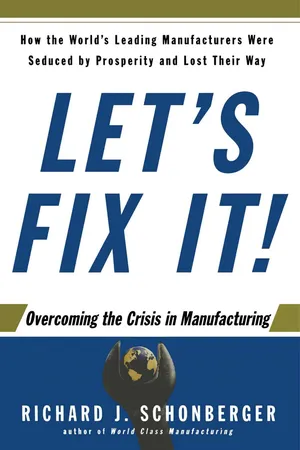
- 256 pages
- English
- ePUB (mobile friendly)
- Available on iOS & Android
About This Book
No company is built to last, argues world-renowned manufacturing guru Richard J. Schonberger. In this devastating indictment of current manufacturing practices, Schonberger submits a four-part revolutionary plan to solve the manufacturing crisis for good. From his statistically reliable database of 500 top global manufacturers, Schonberger finds that by the critical worldwide standard of lean production—shedding inventories –General Motors, General Electric, Toyota, and other world leaders have stopped improving. He presents powerful evidence that in recent years record profits have covered up waste and weakness. Clearly a lack of will to renew and recover from the natural tendency toward regression and erosion, it is more than a matter of garden-variety complacency—devastating as that is in this new era of global hypercompetition. Schonberger asserts that the inclination of industry leaders to engage in stock hyping to gain a quick fix from the dot-com explosion has distracted attention from "the basics" of world-class excellence. Among other villains contributing to the crisis, Schonberger contends, are newly hired managers with no trial-by-fire experience; bad equipment, systems, and job design; and retention of unprofitable customers and anachronistic command-and-control managerial hierarchies.What to do? Just as he introduced the legendary "just-in-time" framework to the West in the 1980s, Schonberger prescribes strong medicine to cure our current malaise. Find your blind spots, he says. Roll confusing, time-sapping initiatives into a master program that is immune from "the flavor of the month." Put lean into heavy-handed control systems. Develop products and standardize processes at "home base" for ease of migrating volume production anywhere in the world.
Frequently asked questions
Information
NOTES
Preface
Chapter I
Chapter 2
Chapter 3
Chapter 4
Table of contents
- Cover Page
- Title Page
- CONTENTS
- Complacency
- Renewal
- Competitiveness
- Programs and Their Half lives
- Success
- Performance Management The Human Side
- Performance Management ControlWithout Controls
- Focused Form and Structure
- Focus Within
- Strategy of Global Proportions
- Continuous Improvement Up to Date
- Manufacturing’s Burdens—and Responses
- Systems Some Come with an “E”
- THE STRONG AND THE WEAK
- INTERPRETATION
- WCP INTERNATIONAL BENCHMARKING STUDYPARTICIPANTS AND GLOBALBENCHMARKINGPARTNERS
- TWO ELEMENTS OF THE WORLD CLASS BY PRINCIPLES WCP INTERNATIONAL BENCHMARKING PROJECT
- NOTES
- INDEX
- RICHARD J SCHONBERGER PH D